Everest Base Camp Trek - Facts, Highlights, Overview, Itinerary, Best Time, Difficulty, Packing List and Permits
Page Contents
Toggle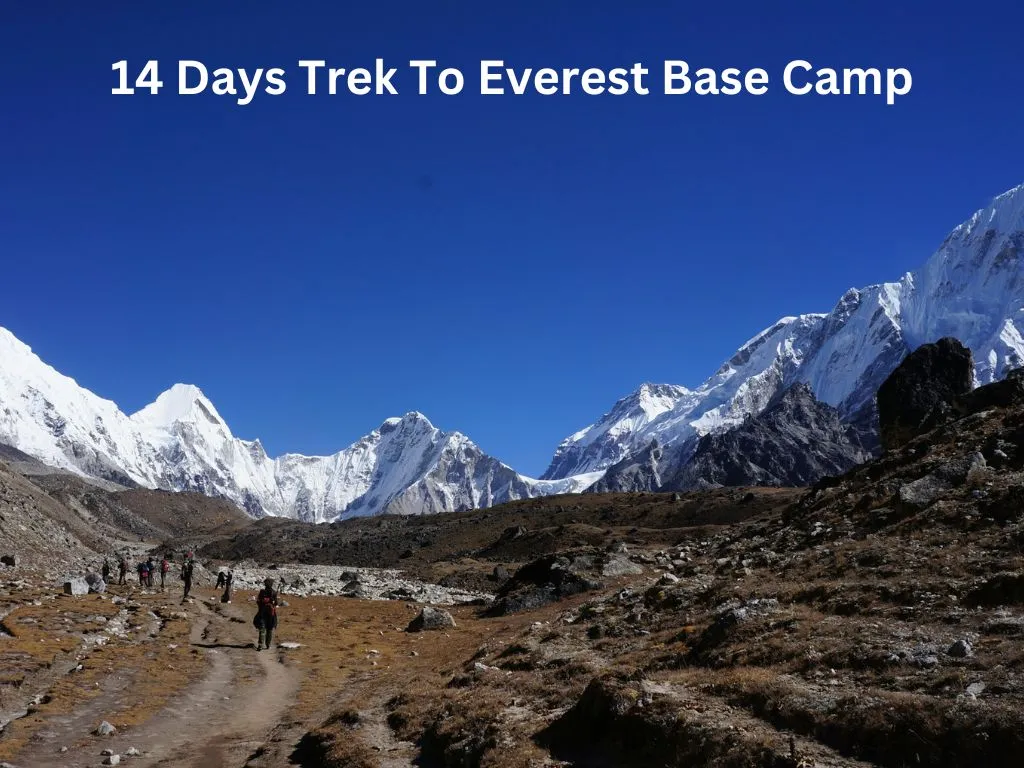
The Everest Base Camp is high on the priority list of trekkers and is one of the most popular destinations for trekking in Nepal.
The base camp sits at an elevation of 5,364 m (17,598 ft) in the Khumbu region of Nepal. The 14 days trek starts and finishes at Lukla also known as the ‘Gateway to Everest’. Most trekkers fly to Lukla to begin the trek. About 40,000 people per year make the trek to base camp from Lukla Airport (2,840 m or 9,317 ft).
Kala Patthar, the highest point on the EBC trek is a famous viewpoint in the Everest region trekking located on the south ridge of Pumori above Gorakshep. The elevation of Kala Patthar is commonly listed as 5,545–5,550 m (18,192–18,209 ft).
The ultimate highlight of the trek is reaching the Everest Base Camp at 5,364 meters and trekking through several Sherpa villages, and exploring ancient monasteries. The trek spans about 130 kilometers round trip from Lukla to Lukla and typically takes 12-14 days. Starting from Lukla, you'll follow the Dudh Koshi River, pass through Namche Bazaar, and ascend to Everest Base Camp, all while acclimatizing to the high altitude.
A typical 14-day EBC trek itinerary includes acclimatization days in Namche Bazaar and Dingboche, with overnight stops at popular villages such as Tengboche and Lobuche. The trek culminates at Everest Base Camp, with an optional hike to Kala Patthar for spectacular sunrise views of Everest. The Spring (March to May) and Autumn (September to November) seasons are the best time to trek to Everest Base Camp. These months offer clear skies, moderate temperatures, and ideal trekking conditions.
This Everest Base Camp Trek is considered streneous, requiring a good level of fitness. The main challenge is the altitude, with the highest point being 5,545 meters at Kala Patthar. Proper acclimatization and preparation are essential. To trek to EBC, you will need two main permits: the Sagarmatha National Park Permit and the Khumbu Pasang Lhamu Rural Municipality Permit.
A good packing is a must for EBC trek. Your packing list should include essential trekking gear such as a down jacket, sleeping bag, and sturdy trekking boots. Don't forget sunscreen, a water purifier, and altitude sickness medication to ensure a safe and comfortable trek.
Trek Facts
- Difficulty: Strenous
- Max Elevation: 5,555 m
- Best Time: Mar, Apr, May, Sept, Oct & Nov
- Transportation: Flight & By Road (Private / Public Vehicle)
- Trek Duration: 14 Days
- Accommodation: Hotel / Teahouse
- Per Day Walking: 5 - 6 Hours
- Trek start and End Point: Kathmandu
Major Highlights of EBC Trek
- Chance to explore the culture and lifestyles of the local Sherpa community.
- The magnificent views of the world’s highest peak, Mt. Everest.
- Visit Hotel Everest View for a 360-degree view of the awe-inspiring peaks.
- Views of 8000 m peaks like Mount Everest (8,848.86m / 29,031ft), Mount Lhotse (8,516m / 27,939ft), Mount Makalu (8,485m / 27,837ft.) and Mount Cho Oyu (8,188m / 26863ft).
- Explore UNESCO world heritage site - Sagarmatha National Park.
- Prayer wheels, colorful flags, Mani walls, high suspension bridges.
- Explore one of the biggest monastery the Khumbu Region, Tengboche (3,867 m / 12,687 ft).
- Witness highest glacier on Earth - Khumbu Glacier (4,900 m).
- Amazing panoramic views from Kala Patthar (5,555m), highest point on Everest Base Camp Trek.
- Adventurous flight to one of the most dangerous airports in the world, Lukla Airport.
- Visit and explore Namche Bazaar - the biggest town in the Khumbu Region.
Everest Base Camp Trek Overview
Upon arriving at the Lukla Airport, the trek in the Khumbu Region starts, with Phakding being the target for the day. The following day, you will travel to Namche Bazaar in Sagarmatha National Park, which serves as the entrance to Mhount Everest. You will spend a day acclimatizing in Namce.
After adjusting to the new environment for a day, you will depart Namche Bazaar and proceed towards Tengboche, another valuable location in the Khumbu region. The route from Namche to Tengboche undulates, offering panoramic views of Nuptse, Lhotse, and other peaks along the way. You will stay overnight at Tengboche.
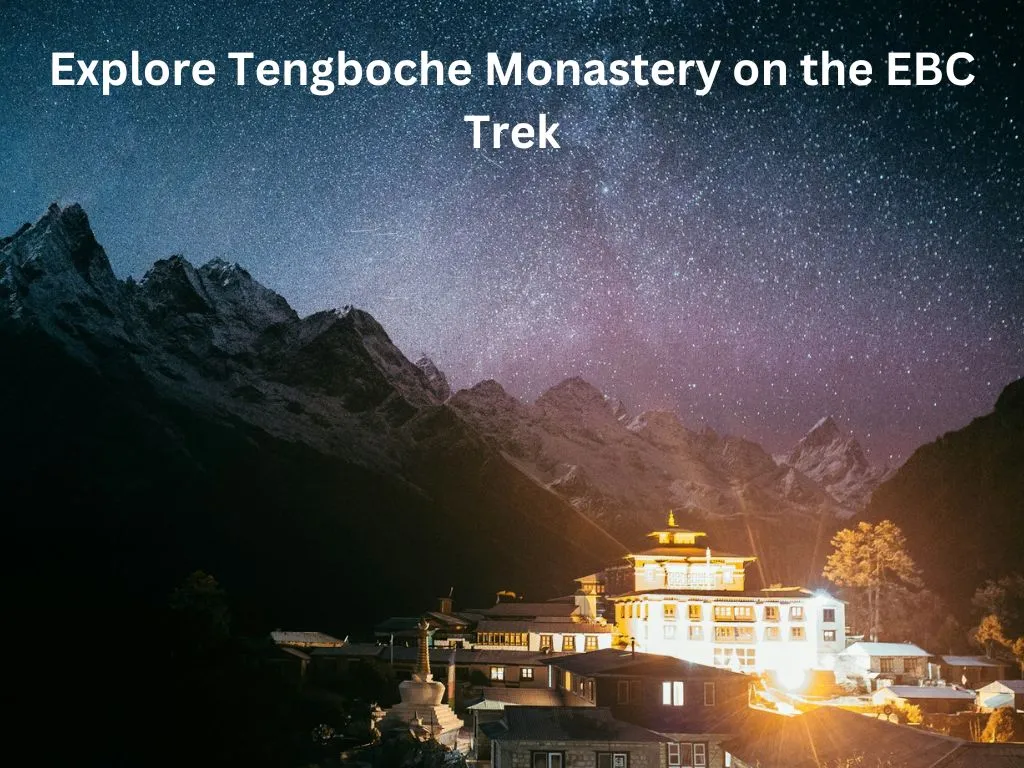
The next day, you will gather yourself and proceed with your tour by hiking to Dingboche (4410m/14470ft), offering a panoramic view of the Himalayan mountains in the Khumbu region. You will travel from Tengboche to Dingboche.
The Pangboche Monastery, constructed in the 16th Century, is located on the route to Dibgboche. Barley, buckwheat, and potato fields in the Dingboche region are enclosed by stone walls to shield them from wind and wildlife. Upon reaching Dingboche, you will have ascended to a high altitude, necessitating acclimatization once again.
Following a day in Dingboche, you will hike to Lobuche (4,940m/16,210 ft) along the Khumbu Glacier, beginning your journey on the path leading up to Pheriche hamlet. While progressing, you will have the opportunity to see the sights of Pumori, Lingtren, and Khumbutse before reaching Lobuche. You will stay overnight at Lobuche.
You are now on the last significant day of reaching the base camp after spending a night at Lobuche. Before arriving at EBC, you will trek to Gorak Shep at an altitude of 5,164m/16,942 feet. You will abandon your possessions at Gorak Shep and trek next to the Khumbu Glacier till you arrive at the Everest Base Camp.
You will spend some time climbing EBC and then take a brief break enjoying the natural splendor surrounding the world's tallest peak. Attaining Everest Base Camp is a significant accomplishment for climbers and explorers. You will go back to Gorak Shep and stay there overnight. The return journey will retrace the trail from EBC to Namche and finally to Lukla. You will stay overnight in Lukla, expecting to return to Kathmandu the following day.
Upon completion of all arrangements, you will fly back to Kathmandu from Lukla on the fourteenth day.
EBC Trek Route Itinerary
Day 1: Drive from Kathmandu to Manthali.
Day 2: Take a short flight from Manthali Airport to Lukla. Your trek starts from Lukla. Trek to Phakding (2,610 m / 8,562 ft) and enjoy the rivers and green mountains throughout the trek.
Day 3: Trek from Phakding to Namche Bazaar (3,440 m / 11,286 ft), the largest town in the Khumbu Region. This day is challenging and involves a big jump in elevation.
Day 4: Today is an acclimatization day. So explore Namche Bazaar and hike up to acclimatize. Take a day hike to the beautiful village of Khumjung or Hotel Everest View for coffee to witness stunning mountain views.
Day 5: Trek from Namche Bazaar up to Tengboche (3,867 m / 12,687 ft), where you can visit the Tengboche Monastery. Tengboche is the largest monastery in Khumbu.
Day 6: Trek from Tengboche to the small settlement of Dingboche (4,260 m / 13,976 ft).
Day 7: Today is an acclimatization day at Dingboche. Take a day hike to Nagarshan Hill (5100 m / 16,732 ft).
Day 8: Trek from Dingboche to Lobuche (4,940 m / 16,207 ft).
Day 9: Trek from Lobuche to GorakshepTrek (5,164 m / 16,942 ft). Keep your belongings in the teahouse at Gorakshep and head towards Everest Base Camp (5,364 m / 17, 598 ft). Turn around and trek down to Gorakshep (5,164 m / 16,942 ft) for the night.
Day 10: Hike to Kalapatthar early morning for Sunrise (5545 m / 18,192 ft). Return to Gorakshep and Trek to Pheriche (4220 m / 13,845 ft).
Day 11: Trek from Periche to Namche Bazaar (3440 m / 11,286 ft).
Day 12: Trek from Namche Bazaar to Lukla.
Day 13: Flight from Lukla to Manthali.
Day 14: Drive from Manthali to Kathmandu.
Everest Base Camp Trek Detailed Itinerary
Day 1: Drive from Kathmandu to Manthali in Ramechhap District.
Your journey to Everest Base Camp starts with a 5-6 hour drive from Kathmandu to Manthali. Manthali lies in the Northeast of Kathmandu valley.
You overnight in the city of Manthali, ready to catch the morning flight tomorrow to Lukla.
Day 2: Take a flight from Manthali to Lukla and trek to Phakding (2,650 m / 8,562 ft).
From Manthali, you will take a 20-minute flight to Lukla. Flying to Lukla is an adventurous journey you won’t experience anywhere else in the world.
Lukla Airport is one of the most dangerous airports in the world. Your trekking journey to EBC starts from Lukla. You will trek to Phakding with a beautiful view of the Dudh Koshi River flowing alongside and green lush forest.
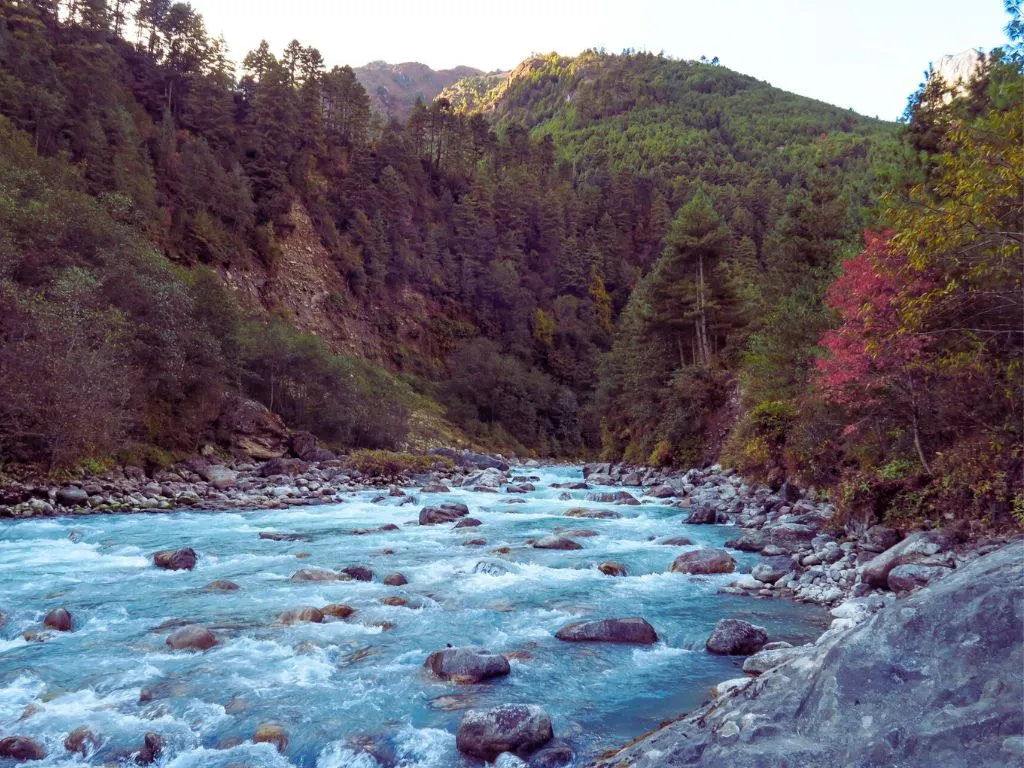
Phakding is a beautiful village with lots of teahouses. Phakding sits in a lush, forested valley alongside the Dudh Khosi River.
Lukla to Phakding is a short hike of 3 hours. You can have a lot of spare time today, get plenty of rest, and prepare for tomorrow's hike.
Day 3: Phakding (2,650 m / 8,562 ft) to Namche Bazaar (3440 m / 11,286 ft).
Today you trek for around 5-6 hours to reach Namche Bazaar. The trail to Namche Bazaar is quite tough and it involves a big jump in elevation of about 800 m.
You will cross many suspension bridges over the Dudh Koshi River, including the famous Hillary Suspension Bridge. As you move forward, you arrive at the Sagarmatha National Park check post, where you will obtain the Sagarmatha National Park entry permit.
After a final steep upclimb, you will finally reach your destination Namche Bazaar.
Day 4: Acclimatization Day at Namche Bazaar.
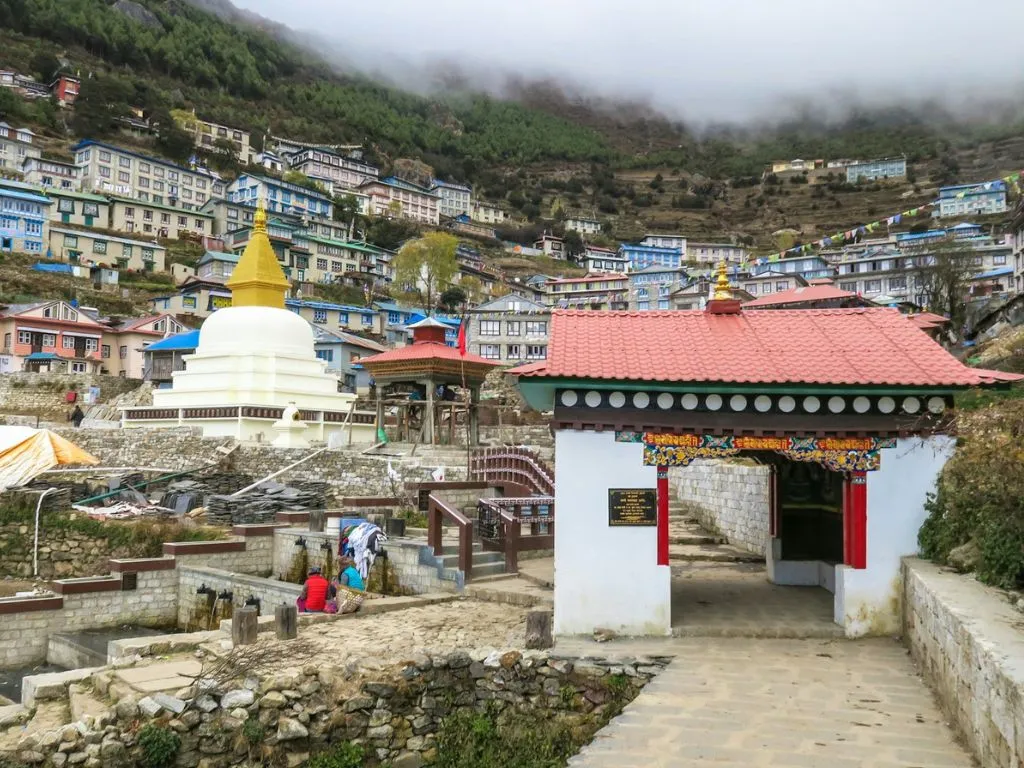
Namche Bazaar is a central trade hub in the Khumbu Region. The small town hosts numerous cafes and restaurants with internet, souvenirs, branded shops, and gear shops. You can have a chill time in Namche Bazaar.
For acclimatization, you can hike to Khumjung village and Everest View Hotel.
Khumjung Village
Khumjung village is a widely spread beautiful sherpa village located at an altitude of 3,790 meters / 12,430 ft. Khumjung Monastery is the main attraction of Khumjung village where you can see ancient yeti scalp.
You can witness Mt. Khumbila (5761 m / 18900 ft) from Khumjung village. Khumbila is said to be an old god, and its name means ‘God of Khumbu’. Most Sherpa people believe the mountain is too sacred to be climbed.
Hotel Everest View
Hotel Everest View is located at an altitude of 3,880 m / 13,000 ft. You can view 360-degree mountain views. If you are an Everest lover, you want to witness the amazing view of Mt. Everest from here.
Day 5: Namche Bazaar (3,440 m / 11,285 ft) to Deboche (3,740 m / 12,270 ft).
The trail to Deboche is full of ups and downs and passes through forests, making the trek challenging. You will feel the altitude as you move forward. The views are truly rewarding. You might also spot musk deer, pheasants, and Himalayan Thars.
You will walk past beautiful mountain views of Mt. Ama Dablam, Mt. Thamserku, and Kangtega to reach Phungi Tenga. It will take you around 3-4 hours to reach Phungi Tenga. After leaving Phunki Thenga, you will ascend continuously for 2.5 hours to reach Tengboche.
You will climb up the famous Tengboche monastery. Tengboche monastery is the biggest monastery in the Khumbu region. You can see stunning views of Everest, Nuptse, Lhotse, and Ama Dablam.
You Settle for the night at the small and quiet village of Deboche. It is a small village located near Tenboche.
Day 6: Deboche (3,740 m / 12,270 ft) to Dingboche ( 4,360 m / 14,290 ft).
Today, you hike for 5-6 hours to reach Dingboche. Throughout the way, you will be passing many Chortens, mani walls, and several small villages including Pangboche, from where you can enjoy the stunning views of Mt.Ama Dablam.
Throughout the trek, you will gain altitude. You will settle in the night at Dingboche.
Day 7: Acclimatization Day at Dingboche.
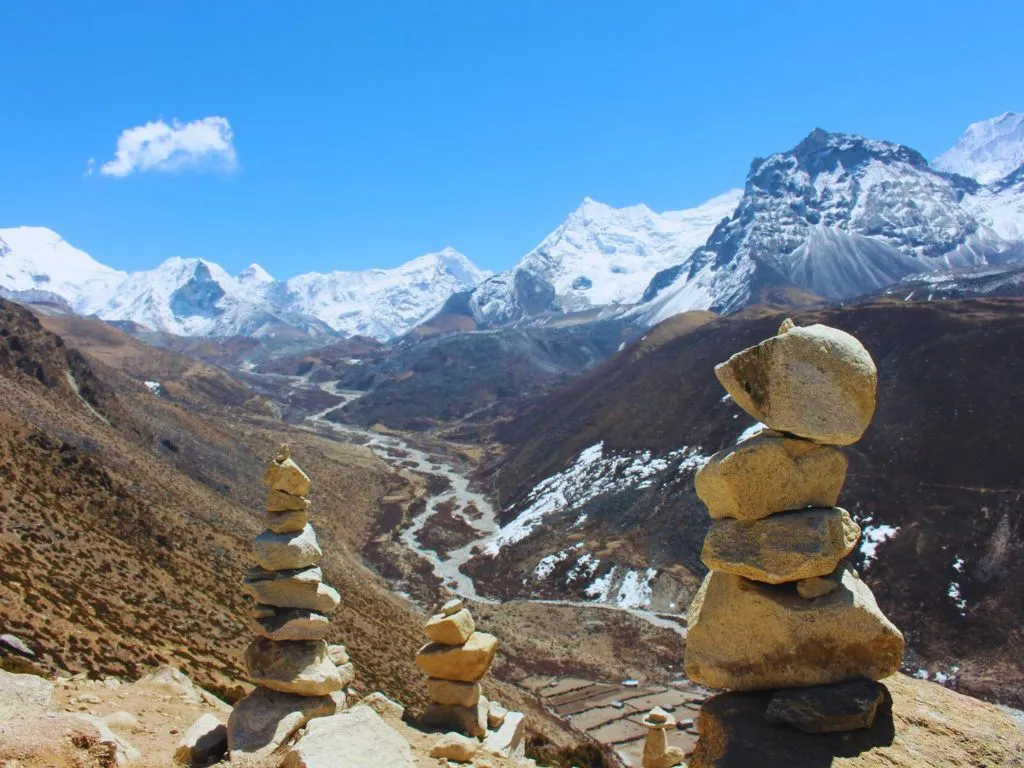
Remember, you are at an altitude of 4,360 m / 14,290 ft and a high risk of AMS (Acute Mountain Sickness) as you will gain more elevation until you reach Everest Base Camp. So, acclimatization is crucial for your body to relax and settle.
You can hike to Chukung or Nagkartsang Peak for acclimatization and witness mountains like Ama Dablam, Island Peak, Cho Oyu, & Makalu.
Day 8: Dingboche ( 4,360 m / 14,290 ft ) to Lobuche (4,930m / 16,175ft).
Trek from Dingboche starts with a trail surrounded by peaks like Ama Dablam, Tanbuche, and Lobuche.
After two hours of journey, you will reach Thukla. Most trekkers stop here to have lunch. The trail after you reach Thukla is steepest and gets only harder with the increased elevation. You will cross through Dugla Pass as it doesn’t get any easier due to the sharp incline.
At the crest of Dugla, you will see a memorial park made in homage to the lost climber at Mt Everest. You trek alongside the Khumbu Glacier until reaching the moraine.
Moving forward, you will reach Lobuche and stay overnight there.
Day 9: Lobuche (4,930 m / 16,175 ft) to Gorakshep (5,185 m / 17,010 ft). Hike to EBC (5,364 m / 17,598 ft) and back to Gorakshep.
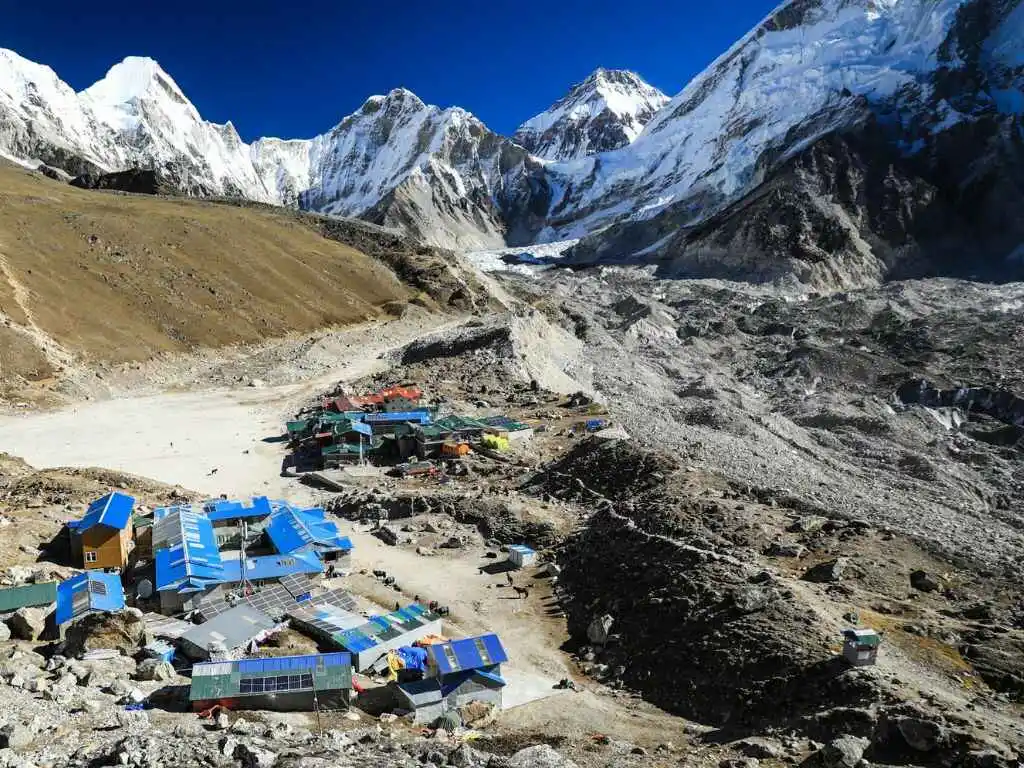
Today, you will reach your most awaited destination Everest Base Camp. Today is also your toughest and longest hike. You start your trek from Lobuche to Gorakshep and again hike up to EBC. You will hike for around 8-9 hours today.
Visiting the Everest Base Camp itself is one of the compelling reasons to do Everest Base Camp Trek.
After trekking along the Khumbu glacier and enjoying the magnificent view of Mt. Nuptse, you will reach the village of Gorak Shep. It is a small village surrounded by Mountains.
After you reach Gorakshep you will keep your belongings at your booked teahouse and then hike up to Everest Base Camp. The trail ahead is challenging as it is rocky and uneven terrain.
Once you reach Everest Base Camp, you will witness the panoramic view of Mt. Everest, Nuptse, Pumori, Khumbutse, and surrounding peaks. After witnessing the Everest Base Camp, you retrace the path back to Gorakshep for your stay.
Day 10: Hike to Kala Patthar (5,555 m / 18,208 ft) viewpoint, trek to Gorak Shep then to Pheriche (4,250 m / 13,945 ft).
Today you hike to the highest point of the Everest Base Camp Trek, Kala Patthar.
Kala Patthar is an excellent vantage point for the incredible views of Lhotse, Nuptse, Pumori, and Mount Everest. You can enjoy the panoramic view of Sagarmatha National Park from Kala Patthar viewpoint.
It is the point from where you can see Mt. Everest from the closest range. Witnessing sunrise view from the Kala Patthar viewpoint is one of the major highlights and the best things to do in Everest Base Camp Trek.
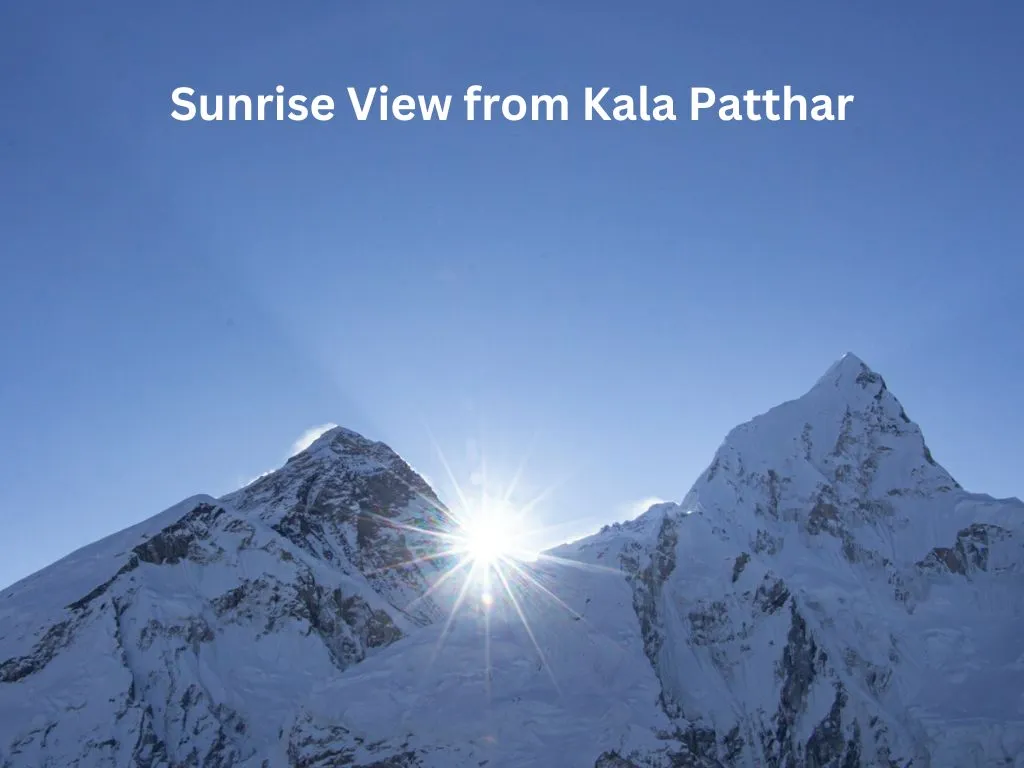
Just hope that the weather is good and kind to you on this day as it is one of the highlights of the whole trek.
After enjoying your quality time at Kala Patthar, you make your way down to Gorakshep and trek to Periche. Periche is the home of the Himalaya Rescue Association. The route takes you through Phangboche, which offers stunning views of Ama Dablam towering above you.
Day 11: Periche (4,250 m / 13,945 ft) to Namche Bazaar (3440 m / 11,286 ft).
Today, you move down to Namche from Periche. As you move forward, you come across Pangboche village. Along your trail, you will also see numerous prayer flags, chortens, and mountain views including Lhotse, and Mt. Everest.
You will cross Hillary suspension bridge, enter the forest trekking trail, and finally reach Namche Bazaar.
Day 12: Namche Bazaar (3440 m / 11,286 ft) to Phakding (2,650 m / 8,562 ft).
Today's trek is a short and easy one to Phakding. You will walk alongside the Dudh Koshi River and cross many suspension bridges.
After passing through several forests and small villages, you will finally reach Phakding. You will stay at Phakding for the night.
Day 13: Phakding (2,650 m / 8,562 ft) to Lukla (2,860 m / 9,383 ft).
Today is yet another short trek and that marks the end of your trekking journey. You have walked through this trail already alongside the Dudh Koshi River and green lush forests.
Day 14: Flight from Lukla to Manthali and drive back to Kathmandu.
Your trekking journey of Everest Base Camp Trek comes to an end. You will have a 20-minute flight to Manthali airport. After reaching Manthali, you will take a road trip back to Kathmandu.
When is the Best Time For the Everest Base Camp Trekking?
Spring and Autumn seasons are the most preferred and the best time of the year for the EBC trek.
The spring season starts in March and lasts till May. The weather during this season is perfect for trekking and sightseeing. The lower mountains and foothills are most colorful during this time as well.
Another favorable trekking season for EBC trek is the Autumn season. Autumn season starts from September to November. The nights can be colder at night but days are generally warm. You can expect snowfall at high altitudes.
Trekking in the winter season starts in December and lasts till February. Trekking is still possible in the season and you can see some trekkers out there but be prepared for temperatures below freezing. The temperature is extremely cold and the trails are very less crowded during this season.
Summer or Monsoon season is not recommended for EBC trek.
Check the detailed guide on best time for Everest Base Camp Trek.
How Difficult is Everest Base Camp Trek?
The Everest Base Camp Trek difficulty level is strenuous and challenging.
One of the most challenging aspects of the EBC trek is the altitude. Starting from Lukla at 2,860 meters, you gradually ascend to Everest Base Camp at 5,364 meters and Kalapatthar at 5,555 meters. The risk of altitude sickness is real, and proper acclimatization is crucial.
The 14-day trek to Everest Base Camp can be exhausting and demanding, taking 5-8 hours each day. The trails vary from gentle inclines to steep, rocky paths, with the most demanding sections around the Khumbu Glacier.
The unpredictable weather on the EBC trail can cause more difficulties and challenges on the trek.
The Everest Base Camp trek is undeniably challenging, but it's also achievable with the right preparation. The sense of accomplishment, the views of the world's highest peaks, and the experience of walking through the heart of the Himalayas make it all worthwhile.
Read more on the Everest Base Camp difficulty to get more insight into the difficulty level of the trek and how to be prepared for the successful completion of the EBC trek.
Related Read: How to get Fit for the Everest Base Camp Trek?
What Should You Pack for EBC Trek?
Planning and arranging a packing list for the trek is not an easy task. Summarizing a packing list for the EBC trek in one short answer is impossible.
As it is a long trek you have to carry lots of trekking gear and equipment with you from travel clothings, extra accessories, medical supplies to toiletries. The packing list will go long enough however, you don't have to carry all the stuffs and it totally depends upon your personal preference.
To make it convenient for you, I have prepared a detailed and comprehensive packing list for Everest Base Camp Trek including travel documents, trekking gears and equipment, toiletries and medical supplies.
Permits For Everest Base Camp Trek
If you follow the regular routes from Lukla to EBC, you need to obtain Khumbu Pasang Lhamu Rural Municipality Entrance Permit and Sagarmatha National Park Entry Permit.
If you follow the classic route from Jiri to Everest Base Camp Trek, you must obtain an additional permit for Gaurishankar Conservational area as Gaurishankar Conservation Area permit.
Khumbu Pasang Lhamu Rural Municipality Entry Permit
Introduced in 2018, this permit replaces the older TIMS (Trekkers' Information Management System) card for the Everest region. It supports local development in the Khumbu area.
Sagarmatha National Park Entry Permit
This permit allows you to enter Sagarmatha National Park, a UNESCO World Heritage Site that encompasses the Everest region.
Gaurishankar Conservation Area Permit
If you choose to trek to Everest Base Camp via the classic Jiri route instead of flying into Lukla, you will pass through the Gaurishankar Conservation Area. This permit is required for that section of the trek.
For more information on permits related to cost and where to obtain, check the detailed guide on permits for Everest Base Camp Trek.
Useful Informations on Everest Base Camp Trek
Meals
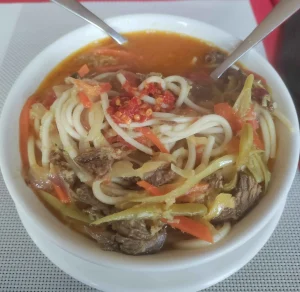
The meal choices at Everest Base Camp will include local, Nepali, and Western cuisine. There are plenty of good, multi-cuisine menu options on this trek like pizza, chowmein, porridge, omelets, and many more.
The most popular cuisines in the trek are lentil (dal), rice (bhat), and vegetables (tarkari). It is a local nepali cuisine rich in carbohydrates and provides enough energy for your trek. It is the best diet that keeps you energized throughout the day.
However, above 3,000m altitude (basically above Namche Bazaar), do not eat meat because teahouses do not have refrigerators. You can even find local bakeries in some of the places which consist of locally made bakery items and are fresh and healthy.
You can expect eggs, toast or Tibetan-style bread, porridge, or noodles for breakfast in all the teahouses.
There will be soups of different kinds, noodles (Thukpa), and pasta in different forms, fried potatoes, fried rice, pizza, more dal bhat, and for dessert, perhaps custard or rice pudding.
Since this is a high-altitude trek, you need enough fluids to remain hydrated and stay safe from altitude sickness. You are recommended to drink green tea, lemon tea, hot lemon, ginger tea, and garlic soup (a must for high-altitude treks).
Do not consume alcoholic products and caffeinated items on the trek.
Accommodation
The accommodation is good and comfortable throughout the trek. You will stay at small teahouses for most of the trek mostly at high altitudes.
The sleeping rooms consist of beds, blankets, and not much else. There are no options for single rooms as you hike up. Sharing a room is perfectly normal. There is no heating in the sleeping rooms.
As you ascend higher, the facilities of single rooms and attached washrooms will decline. You have to stay in the twin-sharing rooms during the trek at a higher altitude with common washrooms.
Electricity and Water
There is a good facility of Electricity throughout the trek. You will find solar-powered electricity supply in almost all the teahouses and lodges. However, You can recharge your camera and mobile phones at an extra cost in the teahouses/lodges as electricity is readily available.
Talking about water, you can easily get packed mineral water in every teahouse and every en-route shop but the prices will be extremely high as you reach high elevation.
It’s always better to carry your water bottle and a thermos for boiled water. However, they will charge you some amount for boiled water.
Do not forget to use water purification tablets if you are filling water from teahouses. Do not drink directly from the river or water tapes.
Communication and Internet
 Wifi services are available throughout the trek. You will have two options for wifi services - Airlink and Everest link wifi cards. You can recharge easily using the wifi cards for 24 hrs and 48 hrs and you can access it throughout the trek till your recharge lasts.
Wifi services are available throughout the trek. You will have two options for wifi services - Airlink and Everest link wifi cards. You can recharge easily using the wifi cards for 24 hrs and 48 hrs and you can access it throughout the trek till your recharge lasts.The Internet service is the only source of communication as you climb up the elevation. Mobile network communication is not possible on most parts of the trek.
It is surprising to know, although being one of the most popular destination treks in Nepal there are no proper mobile network connections on the trail. You must rely on wifi services forced to pay the amount just to remain in communication with your family and close ones.
FAQs on EBC Trek
Yes, there is always a risk of altitude sickness on Everest Base Camp Trek. Altitude sickness is a major problem at high-altitude treks and is always a threat to any trekkers.
Remember, you will reach an elevation of more than 3000 m on Day 3. The elevation gain is frequent on the trek.
Altitude sickness is not correlated to age or fitness and can affect some people worse than others.
Yes, you can trek to Everest Base Camp solo without a guide.
But it is only advised for trekkers who have experiences of high altitude multi-day trekking in Nepal and are comfortable carrying 10-15 kg a day.
The Everest Base Camp Trek takes 14 Days to Complete. The trek distance from Lukla to Everest Base Camp is about 130 Km / 80 miles round trip.
